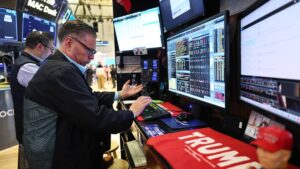Bond markets are sounding the alarm: Stagflation is setting in

Pic via Getty Images
Tariffs are biting, policy uncertainty is rising, and bond markets are already adjusting to a world where sluggish growth and sticky inflation are no longer just risks – they are fast becoming reality.
Investors have taken notice. The once-flat inflation-adjusted US government bonds curve has morphed into a steep climb, a clear signal that the era of cheap, low-risk protection is over.
Yields on longer-term inflation-linked bonds are moving higher, rewarding those willing to extend their duration at a time when both economic momentum and price stability look increasingly fragile.
The shifts happening under the surface are striking. With tariffs acting as a tax on American consumers and tighter immigration policies throttling labor supply, the US economy is absorbing a double hit.
First, prices rise as goods and services become more expensive. Then, demand starts to weaken, eroded by shrinking purchasing power. It’s a one-two punch that leads straight to stagflation: an economy slowing under the weight of its own policy decisions, while inflation proves far harder to tame than many seem willing to admit.
Beyond the immediate squeeze, a deeper force is at work: uncertainty. The jerky cadence of policy announcements — tariffs promised one day, adjusted the next — is dragging down consumer confidence and freezing corporate investment.
Even before the full effects of price rises and potential supply shortages take hold, the economy is losing steam simply because no one knows what’s coming next.
The bond market’s response has been fast and decisive. While nominal Treasury yields remain compressed, real yields are doing something far more interesting: they are climbing, and the curve is steepening sharply.
Elevated inflation expectations are driving a wedge between the front and back ends of the curve, exposing just how dramatically investors are repricing the future.
In portfolios, the approach is changing. The barbell strategy — favouring short and long bonds — thrived when real yields were flatter. Now, the focus is shifting toward the belly of the curve, particularly the seven- to ten-year space where steepness is greatest and roll-down potential most attractive.
Longer duration exposure is also back in favour, offering critical protection if and when slowing growth drags rates lower.
The US is not alone in this reset. In the UK, real yields on index-linked gilts have climbed to levels that would have seemed unthinkable just a few years ago. Twenty-year real yields touching 2% reflect a potent mix of inflation persistence, fiscal concerns and fading demand from price-insensitive buyers like pension funds.
For sterling-based investors, the narrowing gap between UK and US real returns – without needing to take on dollar risk – makes a compelling case for greater gilt exposure.
There’s no pretending this shift is painless.
In the UK, for example, the ongoing tug-of-war between the Chancellor Rachel Reeves and gilt markets is creating a feedback loop: as markets doubt the government’s fiscal resolve, yields climb, making it even harder for official targets to be met.
It’s a reminder that when bond investors lose confidence, they don’t wait politely for policymakers to catch up.
Still, taking a step back from the daily noise, today’s bond market offers something it hasn’t in a long time: real compensation for real risk.
Yields well above inflation expectations – and even above estimates of trend growth – are a rarity that serious investors won’t ignore.
The bigger story, though, is the one already baked into the curves. The bond market isn’t hedging its bets. It’s making a call: tariffs, tighter borders, and policy uncertainty are dragging the economy down, and inflation won’t go quietly. The familiar symptoms of stagflation are already emerging, and portfolios are being rebuilt around this new reality.
For those still hoping that tariffs and immigration crackdowns would boost US growth, the bond market has a blunt message: the strategy is backfiring.
Prices are climbing, growth is slowing, and the safe havens are being redrawn.
Stagflation is no longer a distant threat. It’s the environment we’re already seemingly living in – and it’s reshaping everything from duration strategies to cross-border allocations.
Markets aren’t waiting for official confirmation. They’re already pricing in the consequences.
The views, information, or opinions expressed in the interviews in this article are solely those of the author and do not represent the views of Stockhead.
Stockhead does not provide, endorse or otherwise assume responsibility for any financial advice contained in this article.
Nigel Green, is the group CEO and founder of deVere Group, an independent global financial consultancy.
UNLOCK INSIGHTS
Discover the untold stories of emerging ASX stocks.
Daily news and expert analysis, it's free to subscribe.
By proceeding, you confirm you understand that we handle personal information in accordance with our Privacy Policy.








